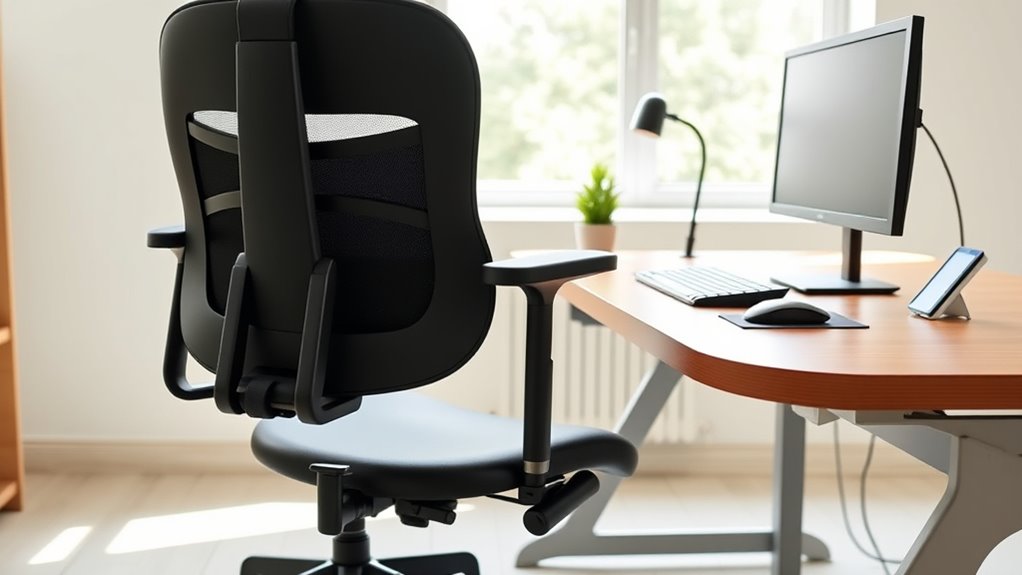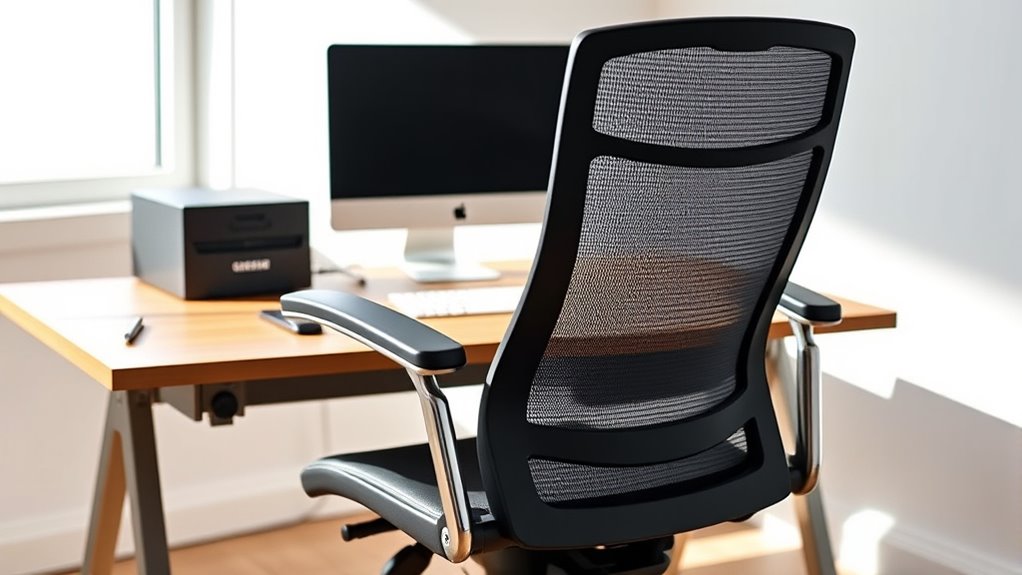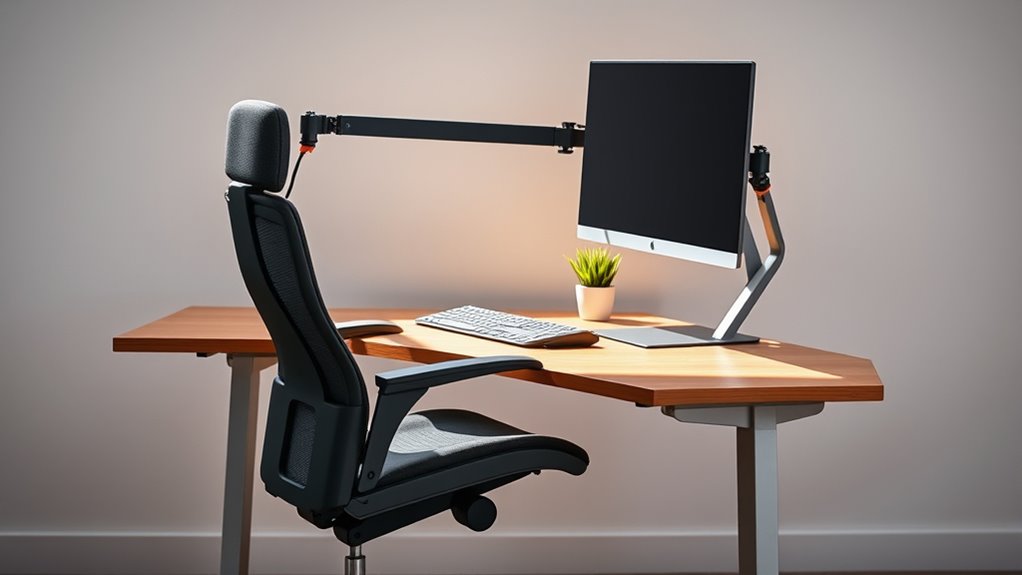Many believe that adjusting your chair and desk height alone creates an ergonomic workspace, but that’s a myth. An effective setup also includes monitor placement, proper lighting, and accessible accessories. Adjusting chairs won’t fix poor posture if you don’t use them correctly, and screen height alone isn’t enough to prevent eye strain. Understanding these facts helps you create a healthier, more comfortable workspace. Keep exploring to discover how to truly optimize your desk setup for better comfort and productivity.
Key Takeaways
- Adjusting chair and desk height alone doesn’t ensure ergonomic comfort; proper monitor placement and accessories are also essential.
- Standing desks aren’t a cure-all; correct usage and posture are crucial to avoid strain.
- Ergonomic benefits extend beyond back pain, improving overall comfort, circulation, and productivity.
- An adjustable chair requires proper setup and correct use to maximize ergonomic advantages.
- Monitor placement at eye level and keeping frequently used items within reach are vital for reducing strain.
Common Misconceptions About Desk Ergonomics

Many people believe that simply adjusting their chair and desk height automatically guarantees an ergonomic workspace, but this is a common misconception. While proper height is important, it’s not enough. Using keyboard shortcuts can improve efficiency and reduce repetitive strain, yet many overlook their benefits. Additionally, standing desks are often thought to eliminate all ergonomic concerns, but standing all day can cause its own issues if not used correctly. An ergonomic workspace involves more than just positioning; it requires an integrated approach that includes proper monitor placement, supportive accessories, and habits like taking regular breaks. Relying solely on desk adjustments or standing desks ignores these essential details. Environmental considerations play a crucial role in creating sustainable and health-conscious setups. True ergonomics promotes comfort, productivity, and health through thoughtful, all-encompassing setup and mindful practices.
Essential Elements of a Proper Ergonomic Workspace

While adjusting your chair and desk height is a good start, creating a truly ergonomic workspace involves more than just these basics. Your keyboard height is vital; it should be positioned so your elbows stay close to your body and your wrists remain straight. This reduces strain and prevents discomfort over time. Additionally, consider your desk material—smooth, stable surfaces made from sturdy materials help maintain proper alignment and prevent slipping. An ergonomic workspace also includes proper lighting to reduce eye strain and adequate space for movement. Keep frequently used items within easy reach to avoid unnecessary stretching or twisting. Effortless passive voice detection can help identify sentences that may weaken your writing clarity. By paying attention to these elements, you create a comfortable environment that supports your posture and minimizes fatigue, ultimately boosting productivity and well-being.
Myths About Adjustable Office Chairs

Despite common beliefs, adjustable office chairs aren’t a cure-all for ergonomic issues. Many people think that simply having an adjustable chair will solve all posture problems, but that’s an ergonomic myth. An adjustable chair is helpful, but it requires proper setup and usage for maximum benefit. For example, understanding the role of contrast ratio can help in selecting the right environment and lighting conditions for a comfortable workspace.
The Truth Behind Screen Placement and Eye Strain

Proper screen placement is essential in reducing eye strain, yet it’s a common misconception that simply positioning your monitor at eye level will eliminate discomfort. While monitor height is important, it’s equally crucial to take into account your keyboard position. Your monitor should be about an arm’s length away, with the top of the screen at or just below eye level, so you don’t tilt your head. If your keyboard is too high or too low, you may strain your neck and shoulders, which can worsen eye fatigue. Adjust the monitor and keyboard so that your eyes look straight ahead and your wrists rest comfortably. Proper alignment reduces unnecessary movement and helps prevent eye strain caused by glare or improper viewing angles. Being aware of small mistakes in your workspace setup can significantly improve your ergonomic health and prevent discomfort.
Debunking the Idea That Ergonomics Is Only for Back Pain

Many people believe ergonomics only addresses back pain, but in reality, its benefits extend far beyond that. Improving your office posture with ergonomic accessories can boost comfort, productivity, and mental focus. Proper setup reduces strain on shoulders, wrists, and neck, preventing repetitive stress injuries. It also enhances circulation and energy levels, helping you stay alert throughout the day. Ergonomics isn’t just about avoiding pain; it’s about creating a healthier, more efficient workspace. Using adjustable chairs, monitor stands, and keyboard supports promotes better alignment and minimizes fatigue. Investing in ergonomic accessories transforms your office into a space that supports your well-being, not just your back. Understanding ergonomic principles can help you make better choices for a healthier work environment. Remember, good ergonomics benefits your entire body and your overall work experience.
Frequently Asked Questions
How Often Should I Adjust My Ergonomic Desk Setup During Work?
You should adjust your ergonomic desk setup every 30 to 60 minutes to promote posture variations and prevent strain. Regular adjustments help keep your muscles engaged and reduce fatigue. Pay attention to how you feel; if you notice discomfort or stiffness, make small changes sooner. Incorporating frequent adjustments into your routine guarantees your workspace remains comfortable and supports good posture throughout the day.
Can Ergonomic Accessories Improve Productivity Beyond Reducing Discomfort?
Yes, ergonomic accessories can boost your productivity beyond just reducing discomfort. Items like ergonomic keyboards, mouse, and supportive chairs help you maintain better posture and focus, minimizing fatigue during long work sessions. When you invest in these accessories, you create a more comfortable workspace that encourages efficiency and concentration. Ultimately, ergonomic accessories support your overall productivity enhancement, allowing you to work longer and more effectively without strain or distraction.
Are There Specific Ergonomic Standards for Different Body Types?
Like Da Vinci tailoring his sketches, you should embrace personalized ergonomics, as there are indeed body-specific standards. These standards consider your unique height, reach, and posture to optimize comfort and health. Customizing your workspace ensures you’re not just following generic guidelines but tailoring your setup to fit your body’s needs. This approach helps prevent strain, boosts productivity, and promotes long-term well-being, making your workspace truly work for you.
How Does Lighting Influence Ergonomic Workspace Effectiveness?
Lighting quality greatly influences your workspace effectiveness by reducing eye strain and boosting focus. Proper lighting minimizes glare, which can cause discomfort and distraction, helping you work more comfortably and efficiently. Position your light sources to avoid direct glare on your screens and use adjustable lighting options whenever possible. With good lighting and glare reduction, you’ll stay alert longer, work more accurately, and prevent long-term eye issues.
What Are Cost-Effective Ways to Upgrade My Existing Desk Ergonomics?
Think of your workspace as a canvas—you can improve it with budget-friendly modifications and DIY ergonomic solutions. Adjust your chair height, add a lumbar pillow, or elevate your monitor with inexpensive risers. Use household items like books for desk height or cushion your wrists with soft fabric. These simple tweaks make a big difference, transforming your desk into a more comfortable, health-conscious space without breaking the bank.
Conclusion
Now that you’ve uncovered the truths behind ergonomic setups, it’s clear that proper workspace design isn’t just a minor detail — it’s your secret weapon against discomfort and fatigue. Don’t fall for myths that could turn your office into a battlefield. Instead, implement these facts and transform your workspace into a fortress of comfort and productivity. Remember, a well-ergonomized desk isn’t just good for your body — it’s the superhero cape your workday deserves.









